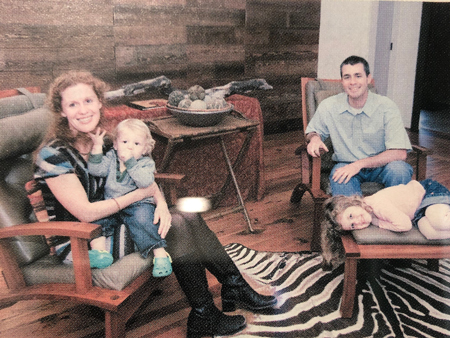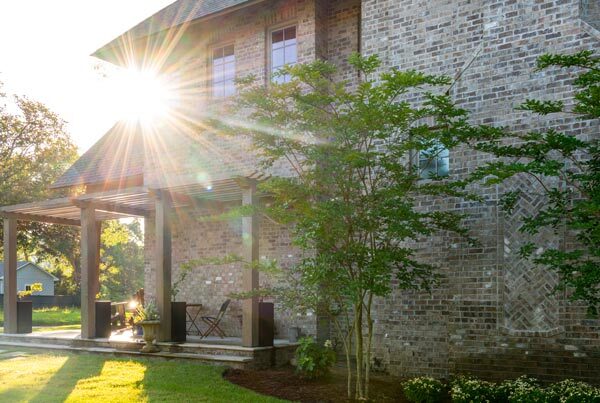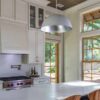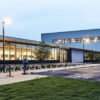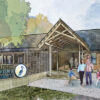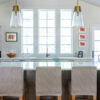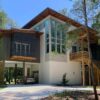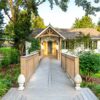Moving Green: Green houses, buildings and communities are the next direction in development.
By Chris McFadyen
Photos by Dennis Holt
As Printed in Mobile Bay Monthly, January 2008
Architect’s Model
When she designed her house in Fairhope, Rebecca Bryant wanted both the perfect Southern-style home and perfect example of sustainability.
Rebecca Bryant, an architect at the Fairhope firm Walcott Adams Verneuille, specializes in green design. Her husband, Clay, is a wildlife scientist, so he shares her enthusiasm for nesting in a living laboratory of sustainability, so to speak. Not that you would know it at first glance.
Starting with the yard, the home does not seem unusual. “Clay really took charge of the outside,” says Rebecca, explaining that the issue of water conservation begins with water conserving fixtures on the inside, but carries over to the choice of greenery in the landscape.
“The storm water that runs off the house sinks into plantings that hold water,” says Rebecca. “Plants that can stand getting really wet and sometimes drying out tend to be native plants.”
The careful planting not only works for periods of flooding or drought, but also earned the small urban lot a designation as a National Wildlife Federation Wildlife Habitat. Birds and butterflies are everywhere.
The house relates to the site. “We picked out paint swatches that would disappear into the trees, and chose a roof to reflect the sky,” says Rebecca. The house is almost swallowed by habitat, by design.
The style of their home is modern farmhouse. The couple took a lot of cues from Southern vernacular homes: the breezeway, screen porches, and the way the indoors and outdoors connect. They also have a tin roof, like many of the neighboring homes. But, what sets the Bryants’ home apart is the green construction.
Originally, Bryant hoped to just add on to the existing, more than 100-year-old Colony cottage at the site. “The greenest thing is not to build at all,” she says, in all seriousness.
But the existing home was too far gone, “not structurally sound.” Some of the wood from the house was recycled into the new home and some donated to Habitat for Humanity.
Short of not building at all, the next greenest practice, says Bryant, is not to overbuild. Less is more.
Their 2,000 square foot three-bedroom, two-and-a-half bath home houses the couple, top right, and their two children, one-year old Aldo and three-year-old Tirza. Add to the layout 1,000 square feet of screened-in porch space that is well used. “Under different conditions, it is both the children’s playroom and a dining room. We have a small area inside, instead of a large formal dining room. But, the porch can be a place to entertain 12 people.”
Creative use of space, “instead of adding a separate room for each use,” is the golden rule. “We have one room that serves as a pantry, a recycling center, my office, and the mud room.”
The trend recently has been to build bigger and bigger. “We tried to keep in simple,” says Rebecca, “and that goes along with wanting to pend more time with the family together. We don’t want our kids to be a mile away in the media room.”
On a recent Saturday afternoon, Rebecca guides a tour for 10th graders in a youth leadership class, pointing out the home’s efficiencies. Husband Clay takes over showing them outside.
Green Standards
The home is certified under the EPA’s and U.S. Department of Energy’s Energy Star program (energystar.gov) which promotes the most efficient building practices, materials and appliances. LEED (usgbc.org) or Earth Craft (earthcrafthouse.com) certifications are more comprehensive green building guides, says Bryant, but have been less attainable in our area.
The U.S. Green Building Council’s LEED certification is the “gold standard”, says Bryant, but the certification for single-family homes is brand new. (greenhomeguide.com)
Southern Sustainability
Efficiencies built into the architect’s home:
- Siting the house under existing mature trees cools it in summer.
- Most rooms receive daylight from two sides, reducing glare and opening up cross ventilation.
- A porch roof bounces daylight into shaded second floor windows.
Southern light keeps the kitchen bright all day. - Metal roof reflects heat, very important in the South where most heat gain comes through the roof.
- Pre-finished kitchen cabinets, floors, and bathroom vanities reduce toxic fumes during construction.
- Mama was right. Wiping feet on 4×6 mats keeps floors – and air – clean.
